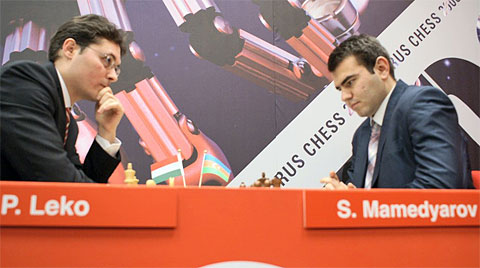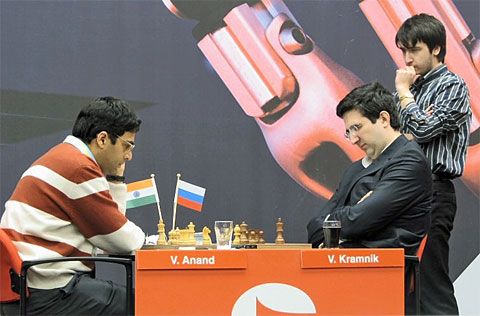Wijk aan Zee 2008

GM Mihail Marin in his analysis kitchen at home in Romania
The following express commentary was provided by Romanian grandmaster Mihail
Marin, who is the author of a number of very popular ChessBase
training CDs and articles for ChessBase Magazine. GM Marin will study the games
of the World Championship tournament in much greater detail and provide the
full results of his analysis in the next issue of ChessBase
Magazine.
Round thirteen commentary by GM Mihail Marin
| Group A: Round 13 - Sun. Jan. 27th |
| Vassily Ivanchuk - Loek van Wely |
½-½ |
| Judit Polgar - Levon Aronian |
½-½ |
| Veselin Topalov - Michael Adams |
½-½ |
| Boris Gelfand - Pavel Eljanov |
1-0 |
| Peter Leko - Shak. Mamedyarov |
1-0 |
| Magnus Carlsen - Teimour Radjabov |
½-½ |
| Vishy Anand - Vladimir Kramnik |
½-½ |
The players chose a nice way to say farewell to the spectators from all continents.
Almost all the games were hard fought, although only two of them were decided.

Leko employed an active plan against Mamedyarov's favourite setup in the Ruy
Lopez. Black did not find efficient ways to neutralize White's initiative and
resigned in a joyless position after 27 moves.
Gelfand-Eljanov started as a balanced positional struggle, but then Black
lost his thread and got under a devastating attack. White won in 38 moves.

The co-winner of the tournament, Magnus Carlsen, at the start of his final
game
The two leaders of the tournament drew their games (Polgar-Aronian and Carlsen-Radjabov)
after prolonged and balanced fights, in 57 and 65 moves, respectively.

Magnus Carlsen watching Judit Polgar vs Levon Aronian

Judit Pogar during her last-round game in Wijk
In the other game with high relevance for the first places, Anand obtained
a promising attack against Kramnik's Petroff defence, but failed to take advantage
of the favourable situation and had to content himself with a draw in 61 moves.

Teimour Radjabov looks on while Anand and Kramnik begin the showdown
Another interesting draw was Ivanchuk-Van Wely, which featured successive
structural modifications and resulted into almost complete simplifications.

The fire extinguisher was not required in the last round...

A rather disappointed Topalov did not seem to find strength to finish the
tournament in the spirit of the Sofia rule and agreed on a draw with white against
Adams after just 23 moves.
Gelfand,B (2737) - Eljanov,P (2692) [A17]
Corus A Wijk aan Zee NED (13), 27.01.2008
[Mihail Marin]
1.Nf3 Nf6 2.c4 e6 3.Nc3 Bb4 4.Qc2 0-0 5.a3 Bxc3 6.Qxc3 b6 7.e3 Bb7 8.b4
d6 9.Bb2 Nbd7 10.Be2
By delaying the advance of the d-pawn to d4, White maintains the indirect control
over the e4-square, preventing the active plan based on ...Ne4 and ...f5.
10...c5
11.0-0 Rc8 12.d4 Now that Black has committed himself to the positional queenside
plan, there are no special reasons to delay this move anymore.
12...Ne4 13.Qb3
Rc7 14.Rfd1 Qe7 15.a4 d5 16.dxc5 bxc5 17.b5 Nd6 18.cxd5 exd5 19.Rac1 Rb8 20.Qc2
Rcc8
This position with hanging pawns is quite complicated. White's dark-squared bishop
looks very strong, but does not have the possibility of creating dangerous threats
yet. Both sides have placed their forces on optimal squares and further improvement
of the position is not easy to achieve. In such situations, a waiting phase is
likely to follow, with both players being concerned about maintaining the harmony
of the position.
21.Ba3!? Not threatening anything concrete, but inhibiting
the advance of any of the central pawns.
21...h6. This natural move, preparing
the occupation of the e6-square with the queen without fearing Ng5, will eventually
lead to troubles. However, the real mistake will come later.
22.Bb2!? White
has some sort of plan now. He will induce a new kingside weakness (...f6) after
which the g6-square will become available for his pieces. The bishop's manoeuvre
cannot be considered a loss of time, because, as mentioned above, it was not easy
to prove a constructive plan.
22...Qe6 23.Qc3 f6 24.h3 Nb6 25.Qc2 Nbc4 26.Ba1
White has achieved his partial aim, but Black has activated his play, too.
26...Re8?!
Black continues manoeuvring, failing to notice that concrete action was called
for. He should have questioned White's stability on the queenside with 26...a6
, now (preferably) or even on the next move.
27.Qg6 Rbd8 28.Bd3 Ne4 29.Nh4!
White has very strong attack now. 29...Ncd6 30.Bxe4 Nxe4 31.Nf5 Rd7 32.Nxh6+
Kf8 33.Nf5 d4 34.exd4 Qa2 35.Rf1 cxd4 36.Bxd4 Qd5 37.f3 Nd6 38.Bc5 1-0. [Click
to replay]
Leko,P (2753) - Mamedyarov,S (2760) [C72]
Corus A Wijk aan Zee NED (13), 27.01.2008 [Mihail Marin]
1.e4 e5 2.Nf3 Nc6 3.Bb5 a6 4.Ba4 d6 5.0-0 [mamedyarov had had a couple
of suspicious positions after 5.c3 Bd7 6.d4 g6 lately, but he managed to survive
every time. Therefore, Leko tries to give play a different, more open, character.]
5...Bd7 6.d4!? exd4. After 6...b5 7.Bb3 Nxd4 8.Nxd4 exd4 White cannot
capture on d4 because of ...c5 and ...c4, winning the bishop, but after 9.c3
his better development would offer him excellent compensation for the pawn.
7.Nxd4 b5 8.Nxc6 Bxc6 9.Bb3 Nf6
10.c4! Before developing the knight, Leko increases his influence in the
centre.
10...Be7 11.Nc3 0-0 12.Re1 Re8 13.Bf4 Rb8 14.Qc2 b4 15.Nd5 Nd7 16.Be3
White has a very active position. Black's defence relies on the control of the
c5-square and the temporary passivity of the b3-bishop.
16...Bf8 17.f3 Ba8
18.Rad1 c6 19.Nf4 Qc7 20.Nd3
20...a5. Black could have prevented the following pawn break with 20...c5
, but after 21.Ba4! Bc6 22.Nf4 White's control over the d5-square ensures him
a stable advantage.
21.c5! After this move, White's advanatge is indisputable.
Black's queen's bishop is passive now and he has lost his stability. At the same
time, all White's pieces are very active.
21...Bb7. The manoeuvre initiated
with this move is too time-consuming to ensure equality...
22.Bf4 Ba6 23.cxd6
Bxd6 24.Bxd6 Qxd6
25.Ne5! Avoiding the exchange on d3 and ensuring the occupation of the
seventh rank. 25...Qxe5 26.Rxd7 Red8 27.Red1 Black's resignation looks
a bit premature, but I must admit I would not like playing on in such a position,
with the f7- and b5-pawns under fire and without chances for counterplay.
1-0. [Click to replay]
Anand,V (2799) - Kramnik,V (2799) [C42]
Corus A Wijk aan Zee NED (13), 27.01.2008 [Mihail Marin]

1.e4 e5 2.Nf3 Nf6 3.Nxe5 d6 4.Nf3 Nxe4 5.Nc3 Nxc3 6.dxc3 Be7 7.Bf4 0-0
8.Qd2 Nd7 9.0-0-0 Nc5 10.Be3 Re8 11.Bc4 Be6 12.Bxe6 Nxe6 13.h4 Qd7 14.Qd5 Qc6
15.Qf5 Qc4 16.Kb1 g6 17.Qh3 h5 18.Nd2 Qe2 19.Rde1 Qg4 20.Qh2 d5 21.f3 Qa4 22.g4
Bd6 23.Qf2
23...hxg4!? In Mexico, Kramnik achieved a relatively easy draw with 23...Ng7
against Svidler. It is hard to say whether Kramnik feared a possible improvement
from Anand (after all, if the World Champion entered this line, he must have prepared
something) or if, having lost with white in the previous round, he was avid for
revenge with black...
24.fxg4 Qxg4 25.Reg1 Qh5 26.Nf3 Re7
White has concentrated all his pieces on the kingside, but in order to successfully
carry out the atack, it would be essential to drive the enemy queen away from
h5, which is not easy to achieve.
27.Bg5 Ree8 28.Be3 Re7. This is more
or less necessary, in order to over-defend f7 and be able to answer Ng5 with ...Ng7,
maintaining stability on the kingside.
29.Bg5 Rd7!? After this avoidance
of the repetition, we can assume that Kramnik intended to play for a win when
he took the pawn.
30.Nd4 Nxd4 31.Qxd4 Bf8
32.Qe3! This move received Kasparov's praise. White temporarily takes over
the control of the only open file and (even more important) enables an elegant
manoeuvre, which will unblock the h-pawn.
32...c6 33.Qh3. The point. Black
has to place his rook on a dark square.
33...Rd6 34.Bf4 Re6 35.Rg5 Qh8 36.h5.
White has a strong attack now.
36...Rae8 37.Bd2 Bc5 38.Rg3 Re2 39.Kc1 Qg7
40.a3!! A truly visionary move, which could have proven of decisive importance,
had Anand found the correct continuation 11 moves later. For the time being, there
seems to be no need to make the a2-square available for the king, but in a certain
line this would prove useful...
40...Bd6 41.Rgg1 Bc5 42.Rg3 Bd6. Playing
for a repetition already.
43.Rg4 R8e6 44.hxg6 Rxg6 45.Rxg6 fxg6
46.Be3! Threatening Bd4.
46...Qe5 47.Qh7+ Kf8 48.Bd2 Qf6 49.Qxb7 Rh2
50.Re1. The careless 50.Rd1? would allow 50...Rxd2! when White is lucky
still that he has a draw by perpetual. However, the intermediary capture of two
(!) pawns with 50.Qa8+ Kg7 51.Qxa7+ Kf8 before playing 52.Re1 would be entirely
viable.
50...Qf2
51.Kb1?! The logical consequence of 40.a3 would have been 51.Rd1!, leaving
Black with problems defending his queenside pawns. Here is the line in which the
a2-square is essential: 51...Qxd2+?
(51...Bf4? also loses to
52.Qb4+)
52.Rxd2 Rh1+ 53.Rd1 Bf4+ 54.Kb1 Rxd1+ and now 55.Ka2.
51...Qxd2 52.Rf1+
Kg8 53.Qf7+ Kh8 54.Qxg6. White maintains strong initiative, but... is a bishop
down.
54...Qg2 55.Qe8+ Qg8 56.Qxc6 Bf8
57.Qa8. According to the kibitzing Kasparov, 57.Qc8 was probably Anand's
last chance for an advantage.
57...Bc5 58.Qxg8+ Kxg8 59.Rf5 Rd2 60.c4 Kg7 61.b4
Be7 1/2-1/2. [Click to replay]
Pictures by Jeroen van den Belt
Links


























































